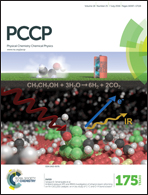Tunneling spectra of graphene on copper unraveled†
Abstract
Scanning tunneling spectroscopy is often employed to study two-dimensional (2D) materials on conductive growth substrates, in order to gain information on the electronic structures of the 2D material–substrate systems, which can lead to insight into 2D material–substrate interactions, growth mechanisms, etc. The interpretation of the spectra can be complicated, however. Specifically for graphene grown on copper, there have been conflicting reports of tunneling spectra. A clear understanding of the mechanisms behind the variability is desired. In this work, we have revealed that the root cause of the variability in tunneling spectra is the variation in graphene–substrate coupling under various experimental conditions, providing a salutary perspective on the important role of 2D material–substrate interactions. The conclusions are drawn from measured data and theoretical calculations for monolayer, AB-stacked bilayer, and twisted bilayer graphene coexisting on the same substrates in areas with and without intercalated oxygen, demonstrating a high degree of consistency. The Van Hove singularities of the twisted graphene unambiguously indicate the Dirac energy between them, lending strong evidence to our assignment of the spectral features. In addition, we have discovered an O–Cu superstructure that has never been observed before.



 Please wait while we load your content...
Please wait while we load your content...